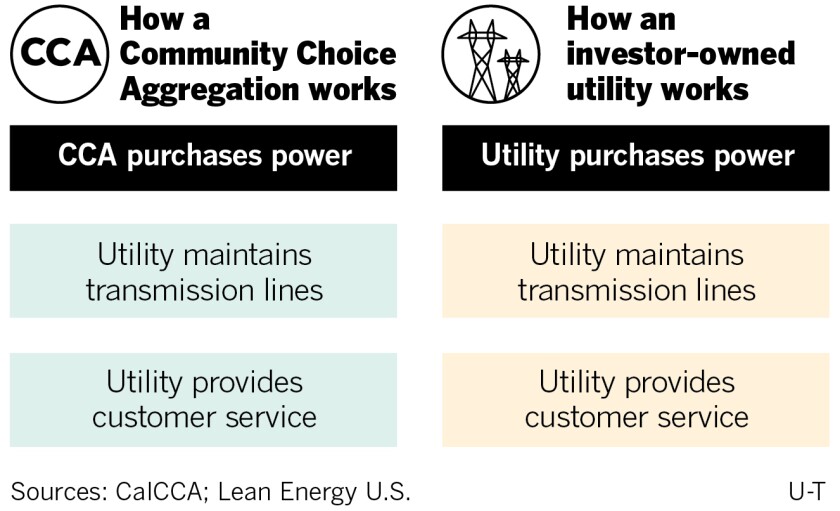After seven years of discussion and debate, a five-city community choice energy program that will provide an alternative to San Diego Gas & Electric when it comes to purchasing sources of power has rolled out the first phase of its operations.
San Diego Community Power, or SDCP — consisting of San Diego, Chula Vista, La Mesa, Encinitas and Imperial Beach — began serving municipal accounts across the five cities March 1 in places such as school districts, fire stations and libraries. By the end of March, about 700 municipal customers are expected to be lined up.
The community choice aggregation, or CCA, program plans for an additional 72,000 commercial and industrial customers in June and is scheduled to fold in 695,000 residential customers in January.
With about 767,700 total customers, San Diego Community Power will be the second-largest CCA in California.
The establishment of a CCA does not, however, mean incumbent power companies go away. SDG&E, for example, will still perform all the tasks outside of power purchasing, such as transmission and distribution of energy and customer billing.
In accord with California rules, all customers in SDCP’s five cities will be automatically enrolled in the new CCA. If customers want to remain with SDG&E, they can opt out of SDCP for free.
“People were very skeptical that this was going to be possible,” said San Diego Mayor Todd Gloria, who in early 2014 helped lay the groundwork to establish a CCA when he served as interim mayor. “Well, here we are, launching this program ... and this shows you what’s possible.”
Gloria said SDCP is key to assure that San Diego meets its climate mandate to go to 100 percent renewables and reduce greenhouse gas emissions by 50 percent by 2035.
SDCP offers two rate plans — PowerOn, which promises to deliver power from 50 percent renewable sources and 5 percent from sources that are free of greenhouse gas emissions; and Power100, a slightly more expensive option that pencils out to 100 percent renewable and carbon-free sources.
SDCP interim Chief Executive Bill Carnahan and Chief Operating Officer Cody Hooven said that while rates vary by class, they estimate customers who opt for PowerOn will pay a monthly bill 2 percent to 3 percent less expensive than SDG&E. If customers choose Power100, the costs would be about the same as SDG&E.
“All our advocates and families have been asking for is choice and competition, so we’re excited to be able to offer that,” Hooven said. “We can do big things here.”
CCAs have been growing in popularity in California for about a decade and now serve more than 11 million customers. SDCP is the state’s 24th community choice energy program.
CCAs were created to boost the use of cleaner energy sources such as wind and solar at rates equal to or lower than investor-owned utilities.

Under a CCA model, local jurisdictions take over one portion of what historically has been a responsibility of investor-owned utilities such as SDG&E — purchasing power for a given community. The decisions regarding power purchases are made by the government officials in a given CCA.
In addition to purchasing power, community energy programs look to use the revenue they generate from customers to invest in renewable energy projects in their areas.
CCAs have their skeptics, though. La Jolla businessman Bill Roper questioned whether SDCP can consistently beat SDG&E when it comes to lower rates over an extended period of time.
“They’re going to be buying power from the same people SDG&E is buying it from,” said Roper, a member of the Strategic Roundtable, a local group that includes retired business leaders. “I’m underwhelmed, but I wish them well.”
SDCP supporters say a joint powers agreement among the five cities creates a legal and financial firewall in case of fiscal problems and point out that in more than 10 years of existence, no CCAs in the state have gone bankrupt.
The California Public Utilities Commission recently announced that 3.3 million residential customers across the Golden State have fallen behind on paying their bills to the major investor-owned utilities amid the financial distress caused by the COVID-19 pandemic.
In SDG&E’s service territory, more than 300,000 residential customers — representing 22.6 percent of the utility’s residential base — are behind on their monthly bills to the tune of $145.3 million.
Since residential customers in SDCP’s five cities will automatically be enrolled in the new CCA, will customers with accounts in arrears lead to the CCA absorbing a big financial hit just as it comes online?
“We check our models regularly, and a lot of the COVID issues are built into the models, so we’re aware of that and are planning for that,” Hooven said. “We’re also seeing a lot of relief coming for ratepayers, so we’re hoping that will be really helpful by the time we enroll” residential customers early next year.
“It hasn’t impacted us yet and it won’t for several months,” Carnahan said, “but I don’t see anything that will be devastating to us because everyone [the CCAs and the investor-owned utilities] is in the same boat.” ◆
"choice" - Google News
March 04, 2021 at 06:24AM
https://ift.tt/3beiHvP
Here comes San Diego Community Power: 5-city community choice energy program launches - La Jolla Light
"choice" - Google News
https://ift.tt/2WiOHpU
https://ift.tt/3c9nRHD
Bagikan Berita Ini















0 Response to "Here comes San Diego Community Power: 5-city community choice energy program launches - La Jolla Light"
Post a Comment